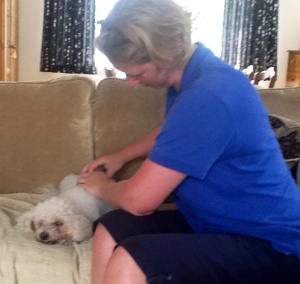As an osteopath, patients come to me with one problem but often during our conversation and my assessment, it becomes apparent that something else is going on. In the last few months, I’ve had a few patients come in who I’ve known or suspected have had sleep apnoea.
So what is sleep apnoea and how does it relate to snoring?
Lots of people snore and the reason for most of us is that at night, the soft tissues of our neck and palate relax and become narrower, causing the air to move in and out faster and causing the tissues to vibrate. Things that make this more likely are being overweight, drinking alcohol (which is a muscle relaxant) particularly in the evenings, smoking or being congested in either the nose or throat (e.g. from colds, nasal allergies or inflamed tonsils) or taking sedatives (source: http://www.nhs.uk/Conditions/Snoring/Pages/Causes.aspx)
This can become a vicious circle, since it is thought that the vibration damages blood vessels that supply the muscles of the head and neck, hence increasing the likelihood of the airways narrowing as the muscles relax, thus making the problem worse. In some people, it might be a relevant factor in neck pain and jaw problems (which might also affect the snoring) – and it’s often a big cause of friction with partners, whose sleep is disturbed (often more so than the snorer’s).
So it’s important if you snore to try to do something about it – this website gives lots of helpful suggestions http://www.helpguide.org/articles/sleep/how-to-stop-snoring.htm.
Another reason for doing something about it is that it may indicate (or progress to) sleep apnoea – which is a condition with potentially serious implications.
Sleep Apnoea occurs when the relaxing and narrowing of the airways during sleep is so severe that it interrupts the sufferer’s breathing, reducing oxygen supply to the brain and causing them to wake up. This can happen 100s of times a night, but the sleeper may not be aware (although often partners will be), however they often suffer from symptoms that are more than just snoring e.g.
– restless/unrefreshing sleep
– frequent trips to the toilet every night
– morning headaches
– excessive daytime sleepiness and irritability
– impaired concentration
– loss of libido
(source: http://www.nhs.uk/Livewell/snoring/Pages/sleepapnoea.aspx)
Daytime sleepiness increases the risks of accidents while driving or operating machinery at work and sleep apnoea increases the risk of high blood pressure, diabetes and stroke, but many people are living with this problem without realising.
If you want to know more about snoring and sleep apnoea, this video explains the difference between them and talks about some of the treatments http://www.nhs.uk/Video/Pages/snoring.aspx
The British Snoring and Sleep Apnoea Association, just round the corner from my Reigate clinic, has a great website with lots of information (www.britishsnoring.co.uk) and offer consultations, or you can see your GP if you suspect you may be suffering from sleep apnoea.
In the meantime, if you are a snorer, there are lots of things you can do for yourself – lose weight, give up smoking, don’t eat heavy meals or drink alcohol less than a couple of hours before bed and tone up your neck and throat muscles.
In a small study of people with sleep apnoea who were given exercises to do, a significant number had improvement in their symptoms and a reduction in their collar size just by doing exercises – you can download my compilation of exercises from that study and other sources here Throat exercises to reduce snoring and sleep apnoea you don’t have to do them all but pick a few to do each day in rotation. Or if you want to tone up your throat muscles while having a bit of fun and stimulating your brain why not take up singing or playing the trumpet or even the digiridoo – another study showed reduction in snoring for taking up this instrument, which (like the trumpet) requires a technique called ‘circular breathing’ to play it successfully.


